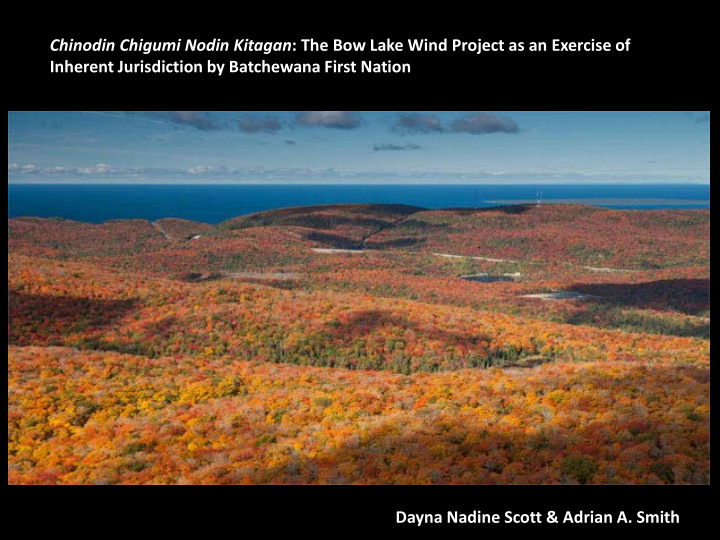



Chinodin Chigumi Nodin Kitagan : The Bow Lake Wind Project as an Exercise of Inherent Jurisdiction by Batchewana First Nation Dayna Nadine Scott & Adrian A. Smith
Chief Sayers: “ The Bow Lake Wind Project is perfectly aligned with our original expectations at Treaty time; those expectations were to benefit from our resources in sustainable ways. [We] will continue to affirm, and benefit from the Letter of Assertions, which outlines our First Nations’ expected relationship with resource developers. This assertion was the foundation for our relationship with our partner, BluEarth Renewables…
Batchewana residents views about the Bow Lake Project DIVISIONS: • Environment / stewardship • Traditional concerns / obligations to the land • Future Generations • UNITED: • Inherent Jurisdiction • “[W]e’ve pretty much always taken that stand…whether it be through commercial • fishing or whether it be logging or use of our lands. We’ve kind of taken that. It’s who we are, right? So we stand united on that front, we’ve never swayed. But you know…we’re trying to take that one step further….to have an ownership stake, to have some input into what’s actually happening.
Own-Source Revenue Trust The objectives of the Own Source Revenue Trust are to: • Plan for the future; • Provide for administration, a building fund and an emergency fund; • Enable spending on identified community priorities; and • Allow for principles of Anishinaabe law to guide the use of revenues “ the collective nature of our rights mean we have to find a way to share the revenues ”
Challenges for Indigenous-Owned Renewable Energy Projects Representation / Meaningful Engagement: “Community power projects -- First Nations • included – are trying to work within a consultative, deliberative model that ensures members are informed and included in decision-making. This tends to take a lot of time. The result is that community power projects risk alienating members or losing the lucrative contracts” . Timing / Financing / Competition for Sites / Grid Access : “entrenched sectoral norms” and • inflexibility of regulators, unrealistic capacity demands on the First Nation To “break into” the power sector, Indigenous communities have to gain first access to the • best local sites for generating electricity: Batchewana’s Letters of Assertion generated a strategic advantage for the community: Because companies and governments were “on notice” regarding their jurisdiction and intentions to exercise it, Batchewana was able to mobilize the incentives put in place through Ontario’s statutory regime in their long-term interests. Expensive Consultants / Working with Private Partners - Indigenous communities may choose • to partner with private firms, such as Blu Earth, to benefit from their prior experience so as to gain access to the larger, more lucrative projects – even understanding the risk that such partnerships may dilute the community’s control and ultimate return.
“shaping public perception of the possible” Indigenous communities are further working within a settler-colonial framework • that at present does not recognize and support exercises of Indigenous jurisdiction and in fact, continues to attempt to subjugate that jurisdiction to Canadian colonial law. Batchewana’s Bow Lake project is an exercise of its jurisdiction and an expression • of its proprietary rights over all resources on its all of its lands, including wind . The establishment of the trust is an insistence on exercising collective control over • the governance, in line with the community’s own social, political and legal order that derives from the specificities of its relationship to the land. To concIude , while there are of course risks and challenges associated with the trend towards equity deals and Indigenous ownership of renewables, we maintain that Indigenous engagement in renewable energy development may offer communities an opportunity: to honour obligations of environmental stewardship; • to sustain less hierarchical governance structures; and; • to maintain communal ownership of resources on their territories better aligned • with their own social, political and legal orders
Land, Landscape and Labour in the Green Economy “sacrifice zones” • Ownership and control of renewables projects by remote communities • Own-source-revenues preserve options for livelihoods outside of the wage • economy
Recommend
More recommend